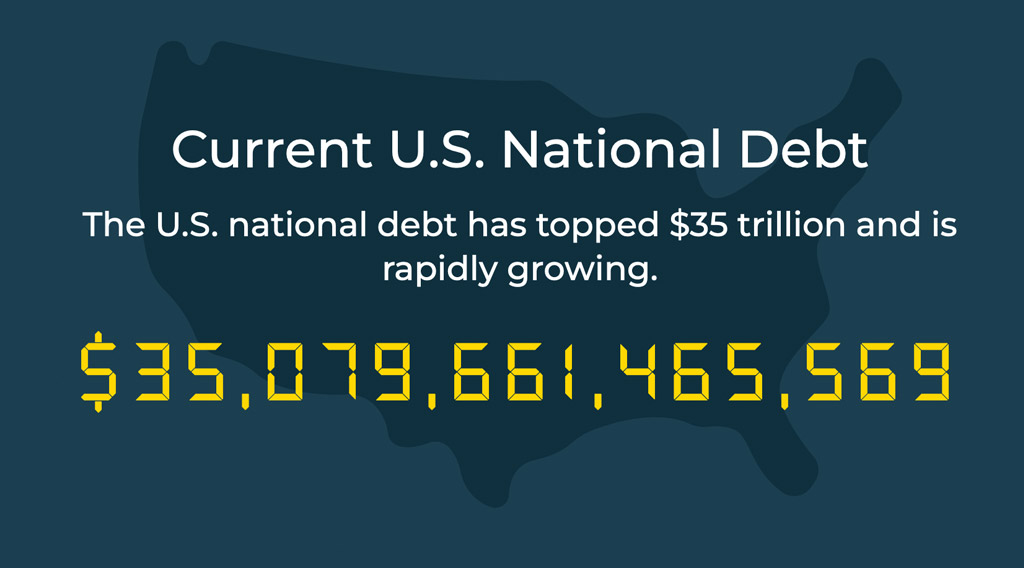The fiscal ticking time bomb of the United States hit another bleak milestone as the national debt surpassed $35 trillion for the first time. While the government is whistling past the proverbial graveyard, investors quite literally can’t afford the same luxury.
Let’s break down what this abysmal milestone means, how individual investors can respond, and what’s on the horizon for Americans.

US National Debt Passes $35 Trillion!
The US national debt officially surpassed $35 trillion on July 26. The federal debt increased by another billion before the Department of Treasury finalized the daily Debt to the Penny tracker, highlighting the rapid pace of debt accumulation. That marks well over $1 trillion added in 2024 alone. At this rate, the federal debt will hit $56 trillion by 2034.
These staggering numbers are difficult to grasp. However, visualizing US debt is crucial for investors to understand the severity of the economic situation. The government’s solvency directly impacts the financial health of everyday Americans. Here are some stats to bring the sky-high debt closer to Earth:
- The national debt equals $104,497 per person or $266,275 per household.
- It’s growing at a pace of $1 trillion every 100 days.
- The debt nearly doubled between 2014 and 2024 from $17.8 to $35 trillion.
- The last time the government owed nothing was in 1835 under President Andrew Jackson.
How US Debt Hurts Investors
The $35 trillion national debt mark might be a psychological threshold that people arbitrarily focus on, but every dollar added to the debt has real-world consequences for investors, such as:
Weaker buying power
Dollar devaluation is one of the earliest and toughest ramifications of surging national debt. The dominos of de-dollarization are starting to fall in response to our government’s fiscal recklessness which means less foreign USD demand and diminished buying power at home. This is the salt in a festering wound of high inflation and rising living costs plaguing American society.
Lower wages
The Congressional Budget Office (CBO) released an eye-opening report connecting federal debt to lower incomes and slower wage growth. If the Fed is allowed to blow the budget over and over again, income growth could be slashed by 1/6th in 2053, roughly $8,000 per person. That number jumps to one-third or $14,100 per person with additional borrowing for spending increases and tax cuts.
Higher taxes
No major party has brought a comprehensive and meaningful debt solution to the table as of yet. In the popularity contest that is politics, nobody wants to make difficult decisions for fear of being ostracized. When the debt issue is truly too serious to ignore, the government will inevitably look to the average American to foot the bill. Biden’s recent proposed 25% tax on unrealized gains foreshadows what unthinkable tax schemes could rest on the horizon.
Diminished nest egg
A toxic brew of stubborn inflation, currency devaluation, economic stagnation, and an aggressive interest rate policy would squeeze Americans’ nest eggs. Traditional assets such as the stock market, stocks, and bonds are burdened by growing debt. Since this is where most people park their wealth, debt diminishes the value and growth of retirement plans. In response, investors can make physical metals part of their nest egg through a precious metals IRA.
The Hidden Hand of Modern Monetary Theory
The silence among the political elite regarding the debt crisis is deafening. Americans are fed up with being lied to about “debt sustainability”, “fiscal responsibility “, and “soft landings”. We want answers and accountability.
While financial elites strategically wave away this inquiry with jargon and overly complicated explanations, the truth is clear: Modern Monetary Theory (MMT) has propelled debt to unparalleled heights. This experimental financial model views debt as an unproblematic asset.
That explains why the Federal Reserve’s “solution” for everything is more spending, more borrowing, and more printing. This isn’t some tinfoil hat conspiracy, either. Our fiscal leaders are vocal about their radical positions.
Just last month, the Secretary of the Treasury Janet Yellen said “If the debt is stabilized relative to the size of the economy, we’re in a reasonable place.” Yet, the debt-to-GDP sits at an alarming 124.7%, closing in on record highs.
At the same time, the cost of servicing the US debt is reaching record extremes. Merely paying off the federal debt is becoming one of the most expensive budget items. Only under the MMT doctrine would this situation be seen as reasonable or sustainable.
US Debt is Pushing Country’s Away
The national debt might be a domestic issue, but it has global consequences. About $8 trillion or one-fifth of US debt is held by foreign governments. That means dozens of nations suffer directly from the debt crisis as it corrodes the dollar’s value and shakes the foundation of major economies.
The US dollar became the world reserve currency due to its stability, value, and performance. The greenback’s waning reputation has led countries to make a concerted effort to lessen their reliance on USD. This global process of de-dollarization further exacerbates USD problems as it threatens a key pillar of declining dollar dominance.
Debt is Fueling a Gold Rush
As national debt hits new highs, gold is responding with its own record streak. The yellow metal has hit several new peaks as investors pour into precious metals amid unprecedented dollar weakness. In fact, experts have raised their gold price predictions to account for the metal’s sharp surge.
Central bank gold buying remains firm as countries exchange their USD reserves for physical gold assets. Retail investors are following suit by hedging their portfolios with physical gold and silver. The world is betting against the dollar in favor of tangible assets with inherent value and a proven track record.
Protect Your Wealth
If you’re interested in learning more about protecting your wealth with precious metals, the advisors at Scottsdale Bullion & Coin would be happy to answer your questions. Get in touch today by calling toll-free at 1-888-812-9892 or using our live chat function.


